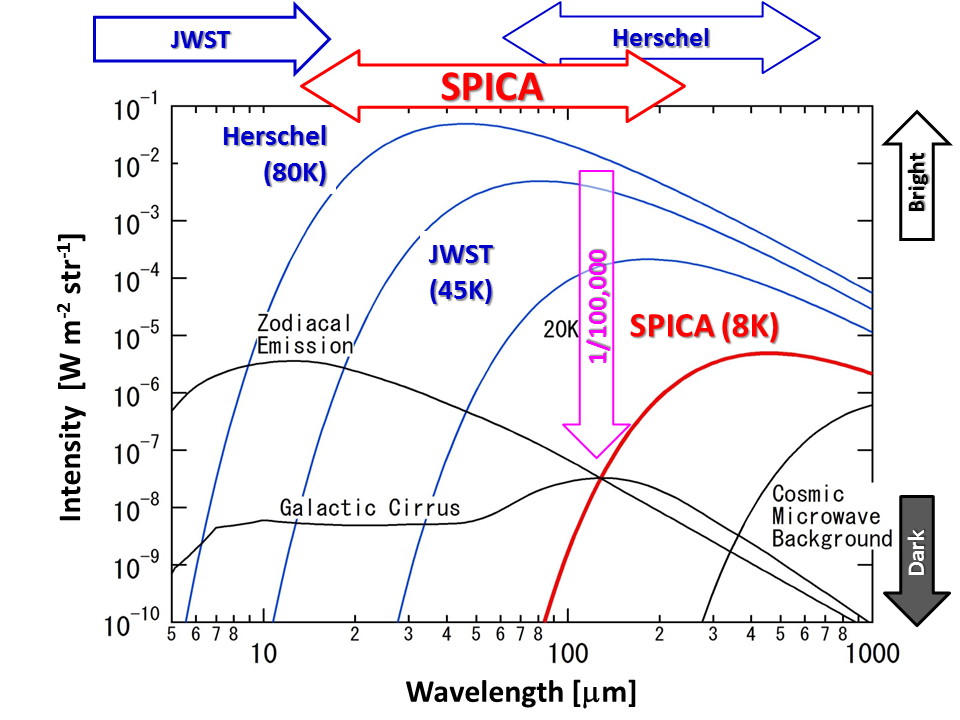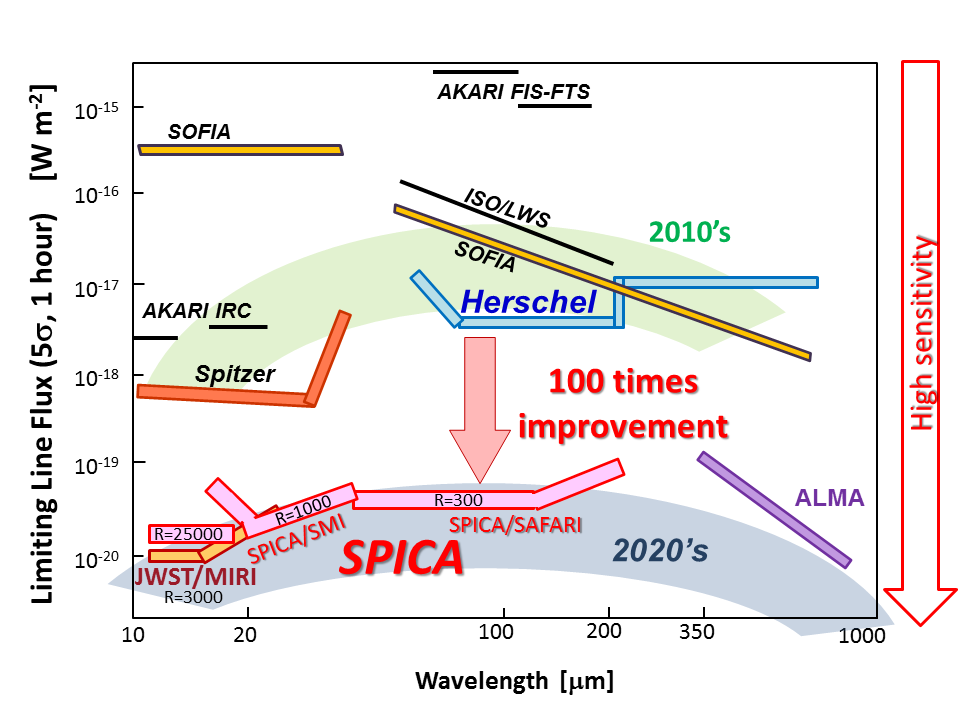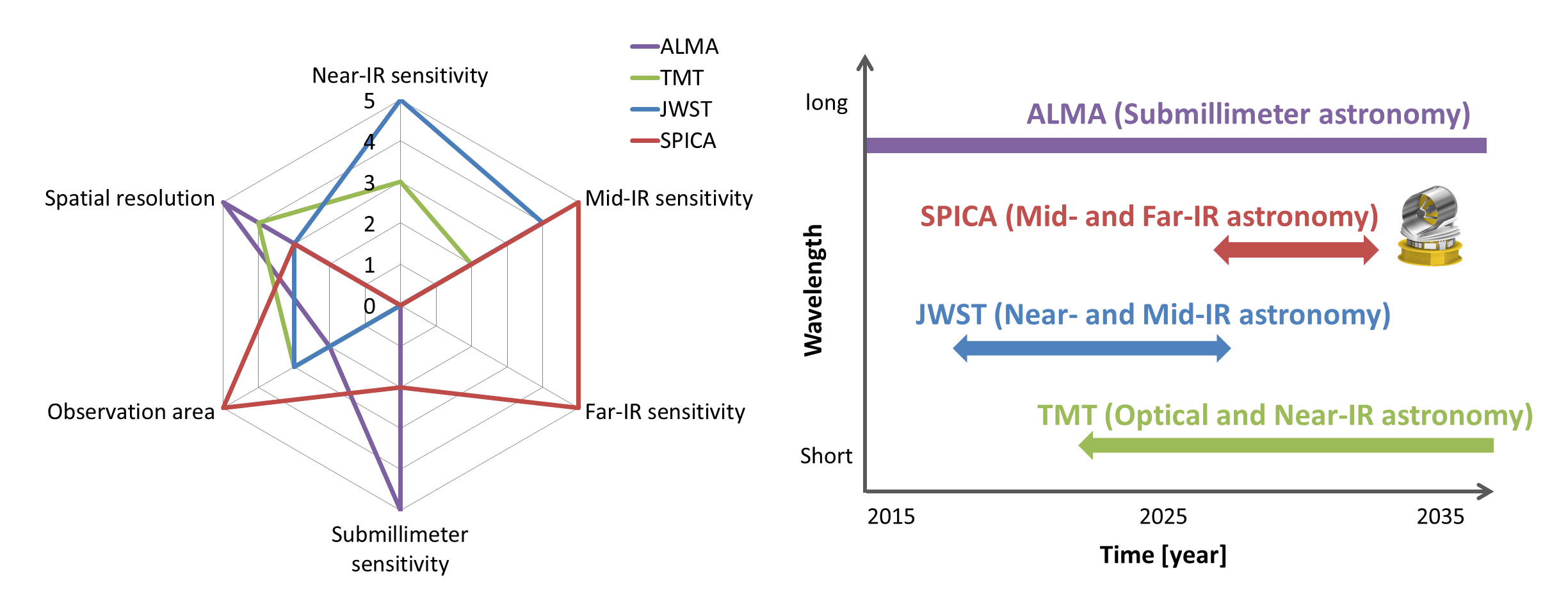The Next-Generation Infrared Astronomy Mission


What's SPICA ?
The Features of SPICA
Home > The Features of SPICA
System Design

| Launch | Target year | 2027-2028 | |
| Launcher | JAXA H3 Launch Vehicle | ||
| Mission life time | 3 years | ||
| Spacecraft | Mass | 3,500 kg (approx.) | |
| Height | 5.3 m (approx.) | ||
| Orbit | Halo orbit around the L2 point of the Sun-Earth system | ||
| Instruments | Mid-infrared instrument (SMI; 12 - 36 μm) |
||
| Far-infrared instrument (SAFARI; 34 - 230 μm) |
|||
| Telescope | Optics | Ritchey-Cretien telescope, diffraction limited at 20 μm | |
| Aperture | 2.5 m in diameter | ||
| Temperature | Below -265 ℃ (8 K) | ||
| Material | Silicon Carbide (SiC) | ||
| Mass | 600 kg (approx.) | ||
| Cooling system | Cryocoolers + radiative cooling (V-groove thermal shields) | ||
Unprecedented Sensitivity Realized by the Cryogenic Telescope
All objects emit infrared radiation at a wavelength corresponding to its temperature (Fig. 1 Left). In order to ensure that the observations are not hampered by infrared emission from the telescope itself, SPICA's entire 2.5 m telescope will be cooled to below -265 ℃ (8 K). The temperature of the SPICA telescope is much colder than that of Herschel (-193 ℃ or 80 K), the European far-infrared space observatory launched in 2009. SPICA will be very cold indeed ! In this way, SPICA will be able to reduce the intensity of the infrared radiation from the telescope by 5 orders of magnitude (i.e., it will be 100,000 times less) and achieve 100 times higher sensitivity (Fig. 1 Right), compared with Herschel. See the details on the cryogenic technology for SPICA in "Cryogenics"


Fig. 1 Left: How bright the telescope is. At some representative telescope temperatures, the infrared intensity is plotted against the wavelength. The red solid line indicates the infrared brightness of the SPICA telescope, while the blue lines show those of other infrared space observatories (e.g., Herschel and JWST). The black lines indicate intensity of infrared radiation from the whole sky. Right: Rough comparison between the sensitivity of SPICA and those of other infrared observatories. Higher sensitivities are located lower in the figure.
Synergy with Other Large-scale Observatories
In the late 2020s, when SPICA is expected to be in operation, other large-scale infrared telescopes such as ALMA in the submillimeter range, TMT in the optical to near-infrared range, JWST in the near- to mid-infrared range, will be also being working. The figures below show a simple comparison of the specifications of those observatories; celestial objects like stars, galaxies and planetary system will be extensively studied with TMT and JWST, while their components, like molecular gas, will be investigated with ALMA. Only SPICA will allow us to figure out the as-yet unsolved processes of star and planetary formation. Collaboration of SPICA and these other infrared observatories can lead to comprehensive understanding of the evolution of stars and planetary systems.

Fig. 2 Synergy of the large-scale observatories in 2020s.
- ALMA : Atacama Large Millimeter/submillimeter Array. A large-scale interferometer, composed of 66 high precision antennas. It is located on the Chajnantor plateau, 5000 meters altitude in northern Chile. It has been in operation since 2013.
- TMT : Thirty Meter Telescope. A project promoted in international collaboration mainly of the National Optical Astronomy Observatory of Japan (NAOJ), the University of California (UC) and the California Institute of Technology (Caltech). The operation is to start in 2024.
- JWST : James Webb Space Telescope. A space observatory, being developed by NASA as a successor of Hubble Space Telescope. The target launch year is 2018.